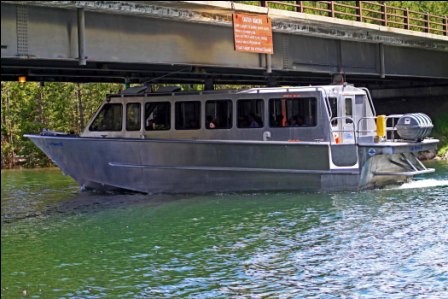
Bob Greenburg, NPS
The Lake Queen II tour boat, operated by Xanterra Parks & Resorts, squeezes under the bridge at Bridge Bay Marina.
Above-average water levels from this spring’s lingering snowmelt nearly broke records in Yellowstone National Park’s lakes and streams this month. The good news is that the water has peaked and is on its way down. The not-so-good news is that a sizeable portion of backcountry trails and some campsites throughout the park remain soggy and muddy, with a marked increase in visitation of hungry insects.
“Pelican Creek has become Pelican Estuary,” proclaimed a recent visiting fisheries biologist studying lake ecology at Fishing Bridge. Visitors to the same area July 9 witnessed water levels that reached 8.7 feet under the bridge, in which 8.9 feet is a park record, and 9 feet is flood stage.
While other rivers in Yellowstone including the Lamar, Gardner, Gibbon, Madison, Firehole, Lewis and Snake Rivers continue to run high and fast, none managed to reach flood level, and are all now on the decline. The most notable remnant of the unusually high water season remains the grandeur of the Yellowstone River rushing over the Upper and Lower Falls in the Grand Canyon of the Yellowstone. The falls are running nearly 10,000 cubic feet of water per second over their 109- and 308-foot drops, respectively -- enough water to fill a railroad boxcar every second.
Turbid, fast running water has kept popular swimming areas such as the Boiling River near Mammoth Hot Springs, and the Firehole Swimming Area, near Madison Junction, closed since May. Until water recedes to safe levels, visitors are prohibited from entering the closed areas and associated waters. Given current river flow volumes, it is anticipated the swimming areas will likely reopen by early to mid August.
All campgrounds in the park are open for the season, but some backcountry trails still have a significant amount of mud and standing water. A handful of trails that are completely submerged have been closed to foot and stock traffic. Swift flowing waterways will be difficult or even impossible to ford for some time. Hikers and anglers need to be alert that what was an ankle-deep wade or small stream leap early in the day has the potential to become a dangerous hazard as water levels tend to rise throughout the evening hours.
Visitors are reminded to exercise extreme caution around high or fast moving water. Rocks and soil along lake, river and stream banks may be slippery or unstable. Water may be moving faster than it appears, and can be powerful enough to knock someone off their feet. Immersion in cold water can also quickly lead to hypothermia, a life-threatening condition. It is strongly advised to consult backcountry offices located throughout the park for current hazard conditions before embarking on treks that cross waterways.
For more information on camping, hiking and other park activities, visit http://www.nps.gov/yell/planyourvisit/index.htm


